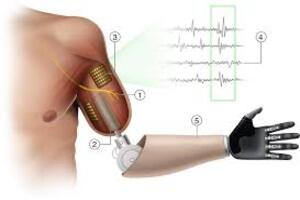By Brian Buck
The briny deep is a dangerous place to get your sea legs. Swashbucklers have long gone after the bounty of the sea, pieces of eight and doubloons. The search for unimaginable riches. Tales of these old seadogs hoping to avoid the ultimate trip to Davey Jones Locker has been stuff of legend.
The captain of the Jolly Roger, the Black Pearl and Long John Silver all had one thing in common. They all 3 are fictional characters of beloved children’s stories about pirate life. However, these pirates all also shared another common thing, prosthetic limbs. As children these stories engage our imagination. We do not even think twice about their disabilities created by “Hook” hands or “Peg Legs”. These stories are fiction, but they do hold some truth. Stories of prosthetic limbs have been around a long time. Fictional tales bring intrigue, imagination about life and are exciting. These stories have taken us to new worlds. Fictional stories derived from factual accounts of history. Real life pirates or men of the sea commonly needed prosthetics. Sea life is dangerous work, and a lot could go wrong if one were not careful. Once a man was fitted with a prosthetic, they usually were no longer able to perform their essential duties, but some would be able to continue to work with the help of prosthetic.
Ancient literature has several references to prosthetics during the rise of the Greek and Roman Empire indicating some of the first known uses of these devices. Egyptians used wood, leather, and metal to fashion them. In the year 2000, an Egyptian mummy was found by researchers using leather to attach a wooden toe to her foot.
Two doctors are credited with the most substantial advancements in the field. French military doctor Ambroise Pare’ during the early 16th century used his techniques for amputation to improve lives. The official royal surgeon to four successive kings, Pare’ performed numerous surgeries on the battlefield.
He later created a mechanical hand and leg that worked with a hinge, featuring attachment harnesses that allowed the user to sit and lock or unlock the device. In 1690 Dutch surgeon Pieter Verduyn developed a lower leg using hinges and leather cuffs to improve how prosthetics would attach to the body.
During the Dark Ages knights replaced lost limbs to keep their honor intact. When a soldier would lose an arm in battle it was commonly replaced with an arm made of wood or metal so the soldier could continue to fight with honor. Before anesthesia cuts had to be quick and well timed. Surgeries became more effective with advances in medicine and the need for prosthetics increased. It was not until 1840 that gaseous anesthesia was developed, and advanced techniques made the process of amputation less dangerous.
During the Civil War there were significant increases in amputees. Approximately 60,000 between 1861 and 1865. Surgeries were difficult and had a low success rate. During the Civil War, the first person to receive an amputation and a replacement prosthetic limb was 18-year-old James Hangar, a Confederate soldier. Hangar went on to invent the Hangar Limb made from barrel staves and metal. This device featured joints at the knee and ankle. The Hangar Limb was so innovative it set a new standard and the J.E. Hanger Company was formed. The company still exists today as Hangar Inc. continuing to innovate in the field of prosthesis.
In 1865 a shoemaker in England named James Gillingham produced an artificial limb using leather molded for a cannoneer that lost his entire arm in an accident. By 1910 Gillingham went on to develop and make custom prosthetics for 15,000 people.
As World War waged on the need increased dramatically and the US was able to manufacture them faster and cheaper than other companies. Continued advancement in prosthetics remained stagnant until 1946. After World War II the National Academy of Sciences created the Artificial Limb Program. An influx of amputees from the war created a need to advance progress and development.
In the 1970’s as a better alternative to wood an inventor and amputee Ysidro M. Martinez invented a lower limb that did not just replicate the motion of a natural limb. The device focused on reducing friction and a person’s natural gait, making walking more comfortable for the user. Between the 70’s and 90’s plastics, resins and laminates were being used to make devices lighter and less difficult to use. These lightweight materials made prosthetics more functional for users. Materials like carbon fiber further advanced the development.
The future of prosthetics is now focused on improving function. New methods and integrated technology that has never been used before is starting to change lives. The integration of brain sensors, custom 3D printed prosthetics and one of kind pieces that mimic movement of natural limbs can even allow the user a sense of feeling. Prosthetic limbs using muscle movement and ultrasound technology are already in use making even greater change possible. Much like the fictional story of the Bionic Man, the development of these limbs are rapidly becoming reality, instead of fantasy.
Are you ready to get your device to market? At Empirical Technologies, we have extensive experience in providing mechanical testing and regulatory consulting. Contact our offices for a free estimate or to further discuss how we may be able to assist with your project.
References
- https://www.ncbi.nlm.nih.gov/pmc/articles/PMC3664166/
- https://unyq.com/the-history-of-prosthetics/
- https://share.upmc.com/2015/03/timeline-prosthetic-limbs-years/
- https://academic.oup.com/jhmas/article-abstract/48/4/454/777933?redirectedFrom=PDF
- https://interestingengineering.com/11-of-the-most-impressive-prosthetics-in-history
- https://rarehistoricalphotos.com/early-prosthesis-james-gillingham-1900/

